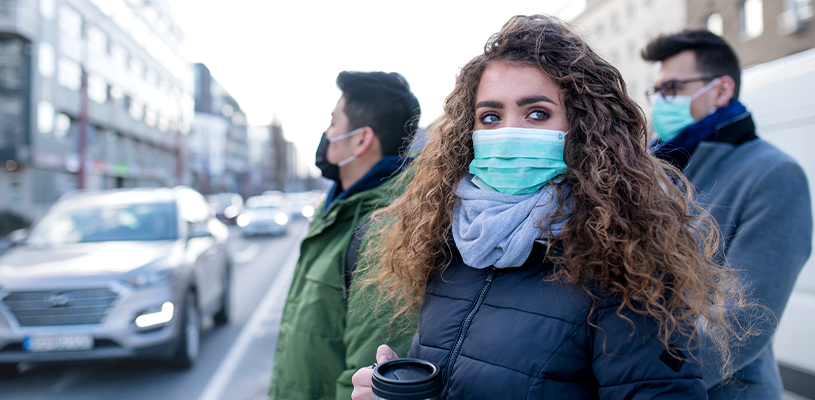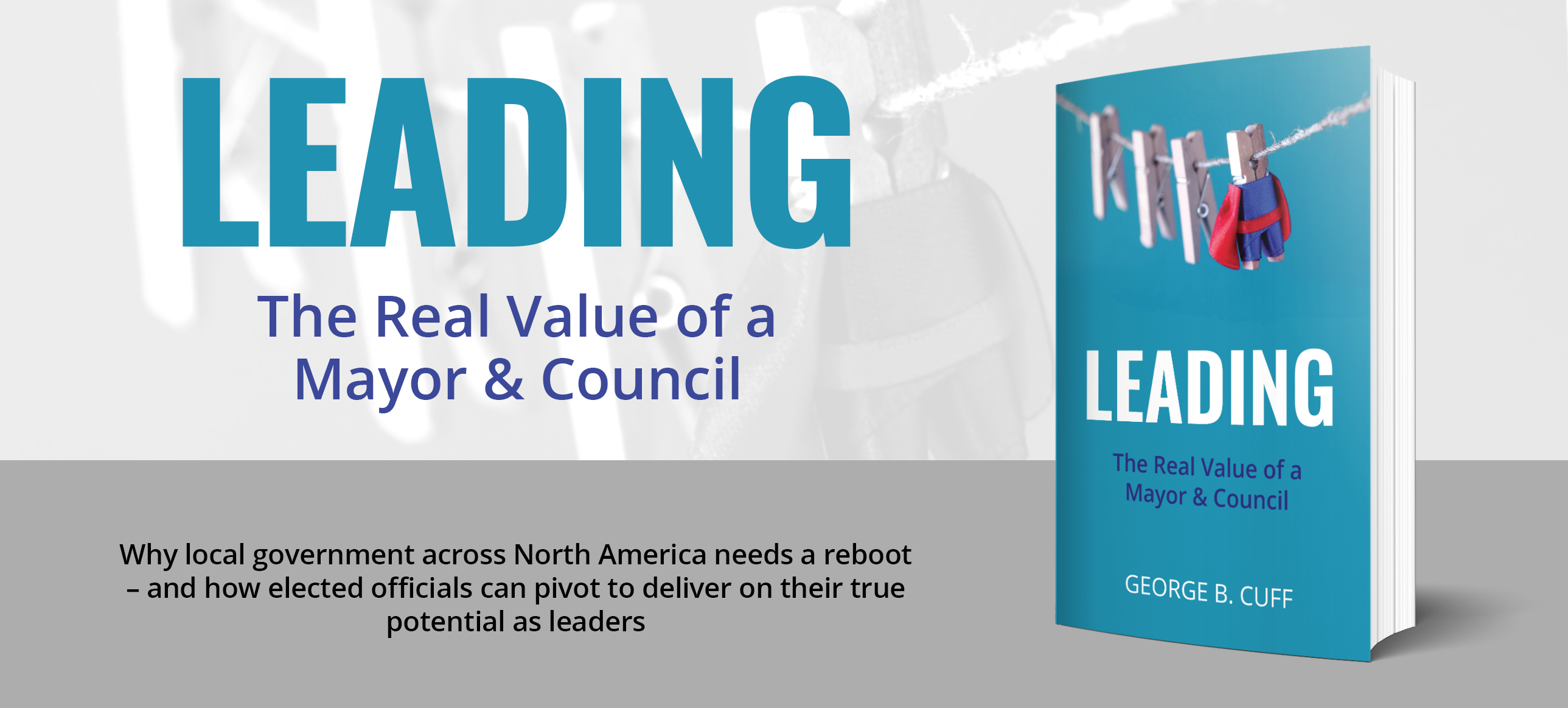Masks and public safety: Local governments can lead in protecting public health

Right this second, there is an asymptomatic carrier of the coronavirus in your community that’s slowly walking up and down every single aisle of your local grocery store. The aisles are narrow; it’s impossible for them to keep six feet from everyone else. It doesn’t matter, they feel fine anyway. They stop to pick up a can of tomato soup and hold it a half foot from their face while inspecting the label. Five breaths go by. Too much sodium. They put it back. Maybe the vegetable soup is better? They get a call and start talking on their cell phone for the remaining eight aisles before hopping on a bus. A quick transfer to another bus, a short walk to their building, an elevator ride up six floors, and they’re finally home.
How many people will this single carrier infect? And how many will those go on to infect? Now, imagine the exact same scenario, except this time the person was wearing a mask – not an N95 or surgical mask, just a simple, do-it-yourself fabric mask that covered their nose and mouth. How many infections would this low-cost intervention prevent? And if we all took this measure, how much more could we flatten the curve and relieve pressure on our healthcare system? How many lives might we save?
We’ve shut down our economies. Told people not to leave their homes. Unemployment is skyrocketing and investments are plummeting. We’ve essentially hit the nuclear option and yet, somehow, we wring our hands over the use of a tiny, square piece of fabric. National and subnational governments all over the world have strongly recommended and, in numerous instances, required their citizens to wear do-it-yourself cloth masks, yet some officials remain reluctant to encourage this simple, effective public health measure. In the absence of stronger federal or provincial leadership on masks, municipal governments can play an important role in leading the way. Your community – and your country – desperately needs this leadership.
Masks Work
Dozens of studies show that putting almost any barrier in front of your mouth and nose is helpful in reducing transmission of viruses. For example, an experiment reported in The New England Journal of Medicine, shows that simply speaking generates droplets and aerosols that have been implicated in virus transmission. Putting a washcloth over a speaker’s mouth virtually eliminates these from entering the surrounding environment. It’s called “source control” and it’s the whole point behind the widespread use of DIY masks.
Here’s a helpful excerpt from The Atlantic on reconceptualizing our typical notions around mask use:
“There’s still a good case for masks, though, even if they can’t stop viruses from getting in: They can stop viruses from getting out. ‘I’ve been slightly dismissive of masks, but I was looking at them in the wrong way,’ Harvard’s Bill Hanage told me. ‘You’re not wearing them to stop yourself getting infected, but to stop someone else getting infected’.” This might be especially important for SARS-CoV-2, which can spread without immediately causing symptoms. If people are infectious before they fall sick, then everyone should wear face masks “when going out in public, in one additional societal effort to slow the spread of the virus down,” says Thomas Inglesby of the John Hopkins Center for Health Security.”
It has also been reported in the The New England Journal of Medicine that the virus “can float in aerosol droplets … for up to three hours and remain infectious.” Several other studies also suggest the virus can spread well beyond two metres via aerosols. This makes the case for source control even stronger.
Widespread use of masks is particularly important since a high percentage of carriers are asymptomatic. Dr. Anthony Fauci, director of the National Institute of Allergy and Infectious Diseases, suggests that between 25 and 50 percent of carriers are asymptomatic. In Iceland, testing broadly for the virus has shown this figure to be around 50 percent. Last week, the Navy tested several thousand crew members on an aircraft carrier and found that 60 percent of the over 600 sailors who tested positive were asymptomatic. Importantly, it’s not just that a large portion of carriers will be asymptomatic; according to a study published last week in the journal Nature Medicine, “viral shedding of patients with laboratory-confirmed COVID-19 peaked on or before symptom onset.” In other words, it may be people who feel healthy that are actually the most contagious.
Even masks that are imperfect can help to reduce the viral dose. From The New York Times:
“The importance of viral dose is being overlooked in discussions of the coronavirus. As with any other poison, viruses are usually more dangerous in larger amounts. Small initial exposures tend to lead to mild or asymptomatic infections, while larger doses can be lethal.”
And which jurisdictions are best flattening the curve? Asian countries where mask wearing is the norm. While correlation does not equal causation, it’s a significant difference worth considering. George Gao, the director-general of China’s Center for Disease Control (CDC), observes: “The big mistake in the U.S. and Europe, in my opinion, is that people aren’t wearing masks. This virus is transmitted by droplets and close contact. Droplets play a very important role – you’ve got to wear a mask, because when you speak, there are always droplets coming out of your mouth. Many people have asymptomatic or presymptomatic infections. If they are wearing face masks, it can prevent droplets that carry the virus from escaping and infecting others.”
The Czech Republic and Slovakia now have mandatory mask-wearing. Their message, “My mask protects you, your mask protects me,” really captures the nature and spirit of the intervention. In fact, the entire country has come together in a massive DIY mask-making effort. Their curve is starting to show evidence of its effectiveness. In Israel, citizens were just ordered to wear masks in public. In Austria, face masks are now compulsory in supermarkets. Singapore, Indonesia, Poland, Philippines, Ukraine, Cuba, Chile, Ecuador, Morocco, Ethiopia, and many other countries have all made masks compulsory in public places where social distancing is difficult. Jurisdictions within Germany, France, Italy, Mexico, and Argentina have similarly required the use of masks in public.
Earlier this month, the CDC issued an advisory in light of asymptomatic transmission that “recommends wearing cloth face coverings in public settings where other social distancing measures are difficult to maintain.” Following this advice, New York, Maryland, Pennsylvania, New Jersey, Connecticut, and Washington DC ordered that members of the public wear masks where social distancing is difficult, such as in grocery stores, pharmacies, and on public transit. Cities like San Francisco, Los Angeles, Miami, Chickasha, and Northampton have all ordered the same. In Laredo, Texas, those who don’t wear masks can be fined up to $1,000. Councillor George Altgelt said, “I’d rather bury them in debt than bury them in a coffin.”
These lists are incomplete. A quick internet search shows that many more jurisdictions are coming on board every day.
Examples of Canadian Leadership on Masks
Closer to home, Toronto’s Michael Garron Hospital has challenged East Toronto sewists to make 1,000 masks every week. The response has been overwhelming. In Baie-D’Urfé, a suburb of Montreal, the community is coming together in a massive mask-making effort. Volunteer Ralph Allison told Global News, “The medical professionals see the people who have the illness … If we can stop the virus, they won’t see us in the hospital.” Maria Tutino, the mayor of Baie-D’Urfé, is calling on leaders in governments across Canada to follow their example. She hopes to see citizens across the country wear masks “in order to protect us all.”
Transport Canada also just announced that they are “requiring all air passengers to have a removable, non-medical mask or face covering to cover their mouth and nose during travel … [as it] can help reduce the inadvertent spread of COVID-19 through respiratory droplets spread by asymptomatic people.” Masks must be shown during the boarding process otherwise the passenger could be denied entry. While less publicized, Transport Canada also came out with stronger recommendations around mask-wearing while traveling by bus. They recommended that bus operators notify passengers that “they should wear non-medical masks or face coverings for the entire duration of their travel … [to] reduce the spread of infectious respiratory droplets … [and] avoid putting the safety of others at risk.” They add that bus operators should “consider denying boarding to passengers who refuse to wear face coverings without a valid justification.” This guidance is particularly relevant for municipalities with public transportation systems. Stronger communications around wearing masks in enclosed spaces or making it a requirement would bring local governments in line with these federal recommendations.
Some local health authorities have also strengthened their messaging on masks. For example, Kingston, Frontenac, and Lennox and Addington Public Health is “recommending that people wear face masks covering their mouth and nose while grocery shopping or any other situation where maintaining an appropriate social distance is challenging.” In a press conference, Dr. Kieran Moore, the medical officer of health, said “you really should be wearing a mask in confined public spaces if we want to stop or contain a second wave of the virus.”
Addressing Objections to Masks
The objections to wearing masks are typically weak and seldom based in any research. Here’s a sampling:
But we need to reserve masks for healthcare workers!
No one who is making the case for widespread use of masks is saying that N95s or surgical masks should be used by the public. These are in scarce supply and need to be reserved for those in healthcare and other frontline workers. It’s a strawman argument. In fact, by wearing DIY masks to help reduce community spread and resulting hospitalizations, we’re conserving N95 masks and other PPE resources used by hospital staff. The argument for DIY masks for the public is actually an argument for more PPE resources for healthcare workers, not less. Messaging from public health officials should be clear on this point. Worried about a run on masks? Try thinking a little better of your citizens. Yes, we’ve all witnessed some poor behaviour during this pandemic but I’ve seen way more examples of altruistic behaviour.
But people don’t know how to use them!
Teach them. Offer guidance. Make videos. Most people don’t know how to wash their hands properly so is our official advice to stop washing your hands? No, that would be absurd. Instead, we issue guidance on how to do it properly. Let’s stop underestimating our citizens. If you learned how to tie your shoelaces, you can probably learn how to put on a mask correctly. It’s difficult to find any research in support of the claim that people can’t learn how to use masks.
But having a mask on will make you touch your face!
Studies vary but it’s safe to say we touch our face a couple dozen times every hour – that’s without a mask. Having a giant thing covering your face can bring an awareness to it that actually helps keep reflexive face-touching at bay. Regrettably, Public Health Ontario lists a study of face-touching behaviour that does not involve the use of masks under the heading “Risks Associated with Wearing Masks.” In fact, there doesn’t appear to be any research that “novice mask-users touch their face more, or that such behavior increases the risk of infection.” From my own experience, I find I touch my face frequently when I’m not wearing a mask at home but have never once touched my face while wearing a mask in public. The act of wearing a mask only heightens my sense of awareness.
But people will have a false sense of security!
It has been reported by public health experts in the prestigious medical journal The Lancet, “there are concerns that mask wearing could engender a false sense of security in relation to other methods of infection control such as social distancing and handwashing. We are unaware of any empirical evidence that wearing masks would mean other approaches to infection control would be overlooked.” The false sense of security narrative appears to come from WHO guidance but they do not cite any research in support of the claim.
This narrative is one that’s been uncritically repeated by politicians and health officials around the world. If this truly is one of the main reasons that we aren’t actively encouraging the use of masks then it would appear that we are depriving ourselves of an important public health measure based on an empty talking point. Again, for what it’s worth, my experience wearing a mask at my local grocery store only increases my level of vigilance around social distancing, not touching things unnecessarily, etc. My mask didn’t detract from other measures; rather, it served as a multiplier and enhanced them.
Moreover, at what number of public health measures do we draw the line? Perhaps we shouldn’t be washing our hands because then people won’t abide by social distancing guidance? Masks add to a bundle of measures that, in their entirety, can help reduce community spread. Issuing an advisory to wear masks should be accompanied by messaging on continuing to abide by other health measures.
But what if the virus got on my mask – I may get it if I touch my mask when I remove it!
This is the strangest objection of them all. What we should be saying is, “Congratulations! That stuff on the outside of your mask was destined for your respiratory tract. This objection is actually an argument for masks. Again, proper communication on mask donning and removal would help here.
Can your municipality require the use of masks?
Here’s an example from legislation in Ontario. Under to subsection 4(1) of the Emergency Management and Civil Protection Act:
“The head of council of a municipality may declare that an emergency exists in the municipality or in any part thereof and may take such action and make such orders as he or she considers necessary and are not contrary to law to implement the emergency plan of the municipality and to protect property and the health, safety and welfare of the inhabitants of the emergency area.”
Would issuing an order to your community to wear DIY masks be “contrary to law”? As far as I am aware, there is no legislation that would come into conflict with or prohibit such an order. It may infringe on a right in our Charter of Rights and Freedoms but, given a state of emergency and a global pandemic, it’s likely that such a health intervention would be justified under section 1 of the Charter.
Does such an order need to first be contemplated in the pre-existing emergency plan that’s required under section 3 of the Act? The words “… to implement the emergency plan … ” suggests that may be the case. If so, your next step would be determined by the contents of your community’s emergency plan. Even if your emergency plan doesn’t specifically contemplate the use of masks, many plans contain clauses that allow for some flexibility given the difficulty of anticipating all the emergencies a community might face. One would have to examine the entirety of a plan to determine if that’s the case.
If such an order does fall outside of what’s contemplated by the existing plan, it can likely be amended by a regular vote of Council. Given that section 3 of the Emergency Management and Civil Protection Act requires an Emergency Plan to be adopted by by-law, it follows that a similar process should apply in making amendments. It’s also worth noting that subsection 3(6) of the Act requires that the plan be subjected to annual review and revised if necessary, suggesting that amendments are a matter of course. Fortunately, most jurisdictions are now allowing councils to meet electronically. It looks like a quick Zoom meeting would suffice.
While I am a lawyer, please note that none of the forgoing is legal advice. It’s simply a quick scan of the legislation and a talking through of what steps might be involved. Please speak to your in-house counsel or seek independent legal advice.
So what should my municipality do?
The big question if you’re in municipal government is how long do you wait for our various public health officials to change their guidance? And at what cost to your community?
While I have a great deal of respect and admiration for our public health officials, now is not the time to worry about stepping on toes and other political or social niceties. Now is the time to think of your duty to those in your community who you were elected to protect. For me, I think of the grocery workers in my city who recently tested positive for COVID-19. I think of the over two dozen staff at my local hospital who also tested positive for COVID-19. I think of our bus drivers. I think of the Facebook post I read that was written by a cashier at a dollar store who says she is “utterly terrified” that no one is wearing masks. She writes: “I’m 63 and have issues in health, but there seems to be [no one who] cares.” I think of all these people and their families and I pray.
When I went grocery shopping last week, at most, five percent of the people there were wearing masks. This isn’t right.
One of the key recommendations from the report produced by Ontario’s SARS Commission was “a call to improve infection control by making sure ‘a precautionary principle’ is the reigning culture” in the public health system. As reported in the Globe and Mail in 2007, “Initially, no one knew anything about the origins of SARS, how the virus could be transmitted, the course of the disease or its death rate. But instead of working from the worst-case scenario that SARS might be spread through airborne transmission and scaling back containment measures as more was learned, the report found that officials waited for ‘scientific certainty.’” The report concludes that “we should be driven by the precautionary principle that reasonable steps to reduce risk should not await scientific certainty.”
How much more evidence do we need before we decide to embrace such a reasonable measure? Every day we delay implementing the widespread use of DIY masks is a day that might soon be measured in lives lost.
Action Plan for Your Municipality
First, if you haven’t already, declare a public health emergency. Cities like Vancouver, Toronto, Calgary, Guelph, and many more have already taken this step.
Second, issue a call to your community to start making masks and to recommend that citizens wear them in public spaces where social distancing may be difficult. Many homemade masks are also now available online.
Third, if your existing emergency plan doesn’t contemplate an order around mask wearing, convene a virtual meeting of council to pass a by-law that makes that amendment and then issue an order requiring the same.
Finally, during the same meeting, pass a resolution calling on federal and provincial health authorities to offer stronger messaging on masks and for governments to mandate their use.
And what if, six months from now, a court rules that it’s beyond the jurisdiction of municipalities to order their citizens to wear masks in public? Perhaps losing a constitutional battle is worth winning an epidemiological war.
Wearing masks is not the norm in Canada, but you can help change that. Setting some pro-mask norms can trickle up and nudge our federal and provincial public health officials in the right direction. Indeed, the use of masks will become even more important when we eventually relax measures to enable us to return to work. Beyond the underlying public health rationale for masks as a source control measure, their widespread use can become a potent symbol. It signals that things aren’t normal. It’s a visible acknowledgment that we’re living through a global pandemic. It’s a social device that will only enhance existing efforts and communicate our solidarity during this difficult period.
Bottom line: People in my community are getting sick. People in your community are getting sick. The numbers are growing every day. If you happen to find yourself in municipal government during this historic global pandemic, please don’t wait for someone else to take charge. Your community needs your leadership. Canada needs your leadership. MW
✯ Municipal World Insider and Executive Members: You might also be interested in George Cuff’s article: Change begins with you (Part 1). Note that you can now access the complete collection of past articles (and more) from your membership dashboard.
Rob Shirkey is a lawyer, an award-winning environmental advocate, and author of a forthcoming book on climate change.
Related resource materials:



